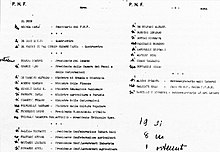Dino Alfieri
Edoardo Dino Alfieri (born December 8, 1886 in Bologna ; died January 2, 1966 in Milan ) was an Italian politician of fascism .
Life
Dino Alfieri studied law and received the laureate in 1911 . Under the influence of Enrico Corradini , he became a fanatical nationalist and in 1910 founded the Gruppo Nazionalista Milanese . He was a soldier during the First World War .
In August 1922 he took part in the fascist attack on the Palazzo Marino in Milan . The fascists appointed him alderman of the Milan commune. In 1924 he was elected to the Camera dei deputati del Regno d'Italia as Milanese deputy of the Partito Nazionale Fascista (PNF) and was re-elected in 1929, 1934 and 1939.
In 1929 Alfieri became Undersecretary of State in the Ministry of Corporations. In 1932 he became Undersecretary of State for Press and Propaganda and in 1932 organized the “Mostra della Rivoluzione fascista” for the tenth anniversary of the March on Rome , which had 4 million visitors. During the deployment of the Propaganda Minister Galeazzo Ciano in the Italian-Ethiopian War , he represented the Propaganda Minister in 1935/36. In 1937 he became Minister of Folk Culture and prepared the ground for the Italian racial laws of 1938.
On November 7, 1939, he was appointed envoy to the Holy See , but after five months he moved to Berlin as ambassador in the German Reich . From May 1942 he was also a member of the Great Fascist Council . In the vote in the Council on 24./25. In July 1943 he voted with a majority of the council for the removal of Mussolini. The new Badoglio government ( Pietro Badoglio ) then called him from Berlin and prepared the change of front. After Mussolini's liberation and the establishment of the Italian Social Republic , he fled to Switzerland on October 24, 1943. At the trial of Ciano in Verona , he too was sentenced to death on January 10, 1944, in absentia. The Swiss Federal Council refused him political asylum , but tolerated his presence. Due to alleged health problems and thanks to the intervention of various exponents of Swiss Catholicism, including the fascist Gonzague de Reynold and the Bishop of Sion Viktor Bieler , Alfieri was able to stay in Switzerland until 1948. On November 12, 1946, a court in Italy acquitted him; on February 6, 1947, the Ministry of Foreign Affairs' investigation ended, and he was able to retire with the rank of ambassador. Alfieri returned to Italy unmolested and worked as a lawyer in Milan.
In the fifties he campaigned in the Partito Nazionale Monarchico , from 1954 Partito Monarchico Popolare , for the re-establishment of the monarchy in Italy .
In his memoirs Due dittatori di fronte, Alfieri described his experiences with Hitler and Mussolini.
No detailed information is available about Alfieri's medals and honors, which were customary under fascism and which Alfieri also wore as evidenced by contemporary photographs.
Fonts (selection)
- Dino Alfieri; Roberto Scheggi, u. a .: La cooperazione nell'Italia fascista . Alpes, Milano 1929.
- Economia liberale, economia socialista, economia corporativa . Augustea, Rome / Milan 1932.
-
Mostra della rivoluzione fascista: guida storica: 1st decennale della marcia su Roma . Partito nazionale fascista, Rome 1933.
- Exhibition of the Fascist Revolution. First tenth anniversary of the March on Rome . National Fascist Party, Rome 1933.
- Due dittatori di fronte . Rizzoli, Milan 1948.
literature
- Mauro Cerutti: Dino Alfieri. In: Historical Lexicon of Switzerland . May 3, 2001 , accessed March 11, 2020 .
Web links
- Literature by and about Dino Alfieri in the catalog of the German National Library
- Newspaper article about Dino Alfieri in the 20th century press kit of the ZBW - Leibniz Information Center for Economics .
- Literature by and about Dino Alfieri in the WorldCat bibliographic database
- Dino Alfieri in the online version of the Reich Chancellery Edition Files. Weimar Republic
- Dino Alfieri , with Treccani
- Dino Alfieri in the Munzinger archive ( beginning of article freely available). The full article was available here in 2014.
- Hubert Beckers: Dino Alifieri (1886–1966) . Biography at shoa.de
Individual evidence
- ^ Friedrich Christof: Pacification in the Danube region. The Second Vienna Arbitration Award and German-Hungarian diplomatic relations 1939–1942 . Lang, Frankfurt am Main 1998. Brief CV on p. 221
- ^ Dino Alfieri , at Portale storico of the Camera dei deputati
- ↑ see Corporatism and Italian Fascism
- ↑ Mauro Cerutti: Dino Alfieri. In: Historical Lexicon of Switzerland .
- ↑ Hubert Beckers: Dino Alifieri (1886–1966)
- ^ Photo by Alfieris on August 27, 1939 , in the Italian Wikipedia
| personal data | |
|---|---|
| SURNAME | Alfieri, Dino |
| ALTERNATIVE NAMES | Alfieri, Edoardo Dino (full name) |
| BRIEF DESCRIPTION | Italian politician of fascism, member of the camera |
| DATE OF BIRTH | December 8, 1886 |
| PLACE OF BIRTH | Bologna |
| DATE OF DEATH | 2nd January 1966 |
| Place of death | Milan |
